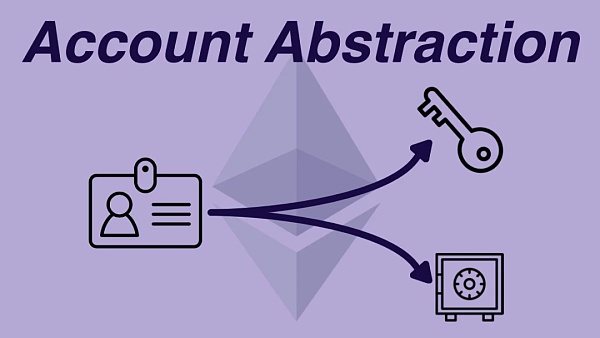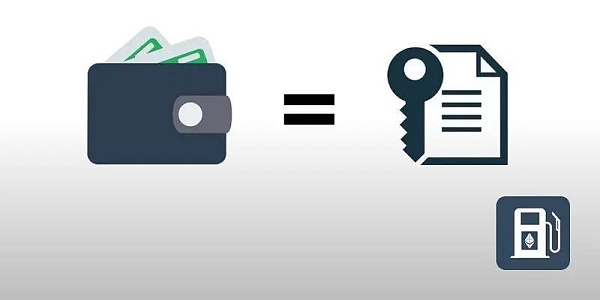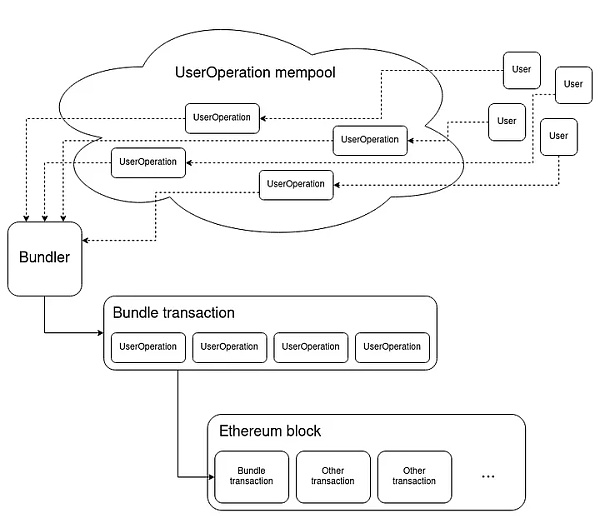Account Abstraction (AA) The Future Web3 Wallet Experience
Account Abstraction (AA) - Future Web3 Wallet Experience.As we all know, Web3 wallets are crucial for blockchain users, but the user experience of most wallets is not very good at the moment, which is also one of the biggest obstacles to its widespread adoption.
In order for new users to interact on the blockchain, they must be familiar with the following operations: creating wallets, securely storing private keys, buying and transferring funds, paying gas fees, and performing tedious operations on various DApps. Therefore, reducing the barriers for new users and improving user experience are prerequisites for the mass adoption of cryptocurrencies.
ERC-4337 is a new “Account Abstraction (AA)” standard that unlocks the functionality of smart contract wallets on the Ethereum blockchain and compatible EVM networks. ERC-4337 is one of the most critical upgrades to the way Web3 wallets work, as it can create a smooth user experience through smart accounts.

- LianGuaiWeb3.0 Daily | Binance Labs announces strategic investment in AltLayer
- Interpreting Lens V2 Will ERC-6551 Bring the iPhone Moment for Web3?
- Q2 2023 Web3 Developer Report Surge in Developer Activity, Rapid Adoption of Account Abstraction…
This article will introduce what AA smart contract accounts (account abstraction) are, how they work, why ERC-4337 is an important upgrade for Web3 wallet user experience, and how to implement “smart accounts” in Web3 applications.
Introduction to AA Smart Contract Accounts
AA smart contract accounts (account abstraction) combine the advantages of current contract accounts and external accounts (EOA), making the accounts themselves “programmable”. While ensuring that assets are held only by smart contracts, they can have more custom and extended functions such as batch transactions, gas delegation, private key recovery, etc. This simplifies the process of on-chain interactions and enables automation of gas subsidies.
Account abstraction (ERC-4337) will be an Ethereum update that allows users to create non-custodial wallets as programmable smart contracts. It unlocks many possibilities such as wallet recovery, anonymous transactions, and team wallets, making the Web3 experience more secure, convenient, and flexible. AA smart contract wallets (account abstraction) are also known as “smart accounts,” “smart wallets,” and “account abstraction wallets,” etc.

Ethereum Account Types
Ethereum accounts are unique digital addresses on the Ethereum blockchain that store ETH and can initiate and execute transactions. Ethereum accounts can be divided into two types: external accounts (EOA) and contract accounts.
External Accounts (EOA):
EOAs are wallets owned by users and operated manually from outside the blockchain ecosystem. They are managed using public and private keys, and as long as the private key is owned, the assets stored in the EOA can be accessed. The most critical part of an EOA is the mnemonic phrase, which consists of 12 randomly generated words (usually 12, sometimes a different number).
EOAs use the mnemonic phrase to generate private keys, and then use the private keys to sign transactions. Therefore, the account owner must store the mnemonic phrase offline to protect against hacking and theft. If a user loses their private key, the mnemonic phrase is the only way to recover the private key and retrieve the assets.
Currently, the most popular cryptocurrency wallets are mostly EOA, such as Coinbase Wallet and Metamask. EOAs are a key part of the Ethereum ecosystem, but they are limited in functionality and flexibility, typically only able to perform two actions: transferring tokens to other EOAs or initiating transactions to trigger another smart contract.
These design limitations present several challenges:
1. Weak security: The security of EOAs is directly related to the mnemonic phrase. If a user loses their private key and mnemonic phrase, they may lose all their assets. Additionally, there are no social recovery options. Furthermore, users cannot set spending limits, enable two-factor authentication, or other security settings.
2. Lack of customization: Transactions initiated by EOAs cannot be customized or automated. Users must manually sign each transaction.
3. Gas payment: Users must have ETH to pay for transaction gas, but new users typically do not have ETH.
Therefore, although EOAs play an important role in the Web3 journey, the user experience is poor, especially for most new users. Therefore, EOAs are not the ideal way for blockchain to be widely adopted. Attracting a large number of new users requires a simpler user interface, better security, and greater flexibility.
Contract Accounts:
Contract accounts use smart contracts as cryptocurrency wallets. Various logic can be encoded into smart contracts to customize transactions and add additional functionality to contract accounts. However, contract accounts do not have private keys or mnemonic phrases and cannot initiate transactions on their own.
When transactions from EOAs trigger smart contract code, they can only perform a certain operation. This means that users need to maintain an EOA with an ETH balance to interact with contract accounts. This makes operating contract accounts more inconvenient than operating independent EOAs, but account abstraction can change this.
How Account Abstraction Works
The most important innovation of account abstraction and ERC-4337 is not based on contract wallets, but the ability to abstract (separate) individual EOAs or contract accounts. Account abstraction allows the creation of independent smart contract accounts that can execute transactions without the need for an EOA. Any custom operation defined in the form of smart contract code can be implemented in a smart account.
Smart account operations are simple. Instead of sending regular transactions like EOAs, they use a “User Operation” object to represent user actions. The User Operation object has multiple data elements that describe the transaction type, token, gas prices for each step of the transaction, signature verification, and other data.

Based on “account abstraction,” when a user operation is sent, the transaction enters a common waiting area called the “Mempool.”
Then, these requests are bundled together by a bundler, similar to validating regular transactions. They use the same logic as validating nodes to determine the transactions that can extract the maximum value. The bundled user operations are sent through a single entry point on a whitelist, where different functions are called to validate and execute each individual user operation.
In simple terms, this is not actually a wallet, but a smart contract. However, you can use it as a wallet, so it is called an “abstract” account. The advantage of doing this is that it can implement some new and better user experiences. So what are the specific features?
Ethereum Smart Account Features
Because user operations can contain any type of logic, it allows users to implement various custom operations on how to manage their accounts and funds. Here are five use cases for abstract accounts:
Wallet Recovery
Unlike externally owned accounts (EOA), the security of a smart account does not depend on mnemonic phrases or private keys. The owner of a smart account can set multiple devices, individuals, or third-party services as wallet custodians. If the account owner loses their account credentials, a custodian can sign a transaction to allocate new credentials to access the smart account. This process does not compromise the account owner’s control or ownership of assets.
Merging Transactions
Exchanging one token for another in a decentralized exchange (DEX) requires two separate transactions. First, the user needs to use their private key to sign an approval for the DAPP to use the token they want to exchange. Then, they need to sign a transaction to execute the exchange. Other more complex Web3 transactions may require three or more signature approvals.
Smart accounts can consolidate multiple transactions and approve them all at once, making DeFi transactions as simple as traditional financial transactions.
Shared Accounts and Team Wallets
With an EOA account, the owner can control full access to the account through a mnemonic phrase. If they want to share permissions with others, they can only give full access or keep all the permissions to themselves, with no middle ground.
However, with abstract accounts, the account owner can share different levels of wallet permissions with multiple users. For example, the account owner can create a multi-signature requirement where two or more users need to sign a transaction for it to be executed. Additionally, they can add users who can only spend limited funds for a specific wallet within a certain time frame.
Automated Transactions
When using an EOA, users must manually initiate or sign every transaction on a DAPP. This process cannot be automated for trusted transactions. In a smart account, users can define a series of parameters such as access to specific tokens, spending limits, duration, gas limits, and specific operations based on preset trigger conditions.
Using Tokens as Fee Tokens
With an abstract account, even if there is no Ether in your account, you can still use other tokens, such as USDT, as fees for account operations when supported by necessary third-party service providers.
In summary, the features of an abstract smart account include multi-factor authentication and account recovery; merging multiple steps of interaction that were previously required for ordinary accounts (such as token exchange on a DEX) into a single step; eliminating the reliance on the native chain coin for gas, allowing the use of any token, including stablecoins, to pay for gas, and enabling third-party gas payment; and more possibilities, as the wallet of a smart account itself is a contract, with the same security as non-custodial wallets, allowing for more custom functionality.
The Challenges and Prospects of AA Smart Accounts
Currently, there are still compatibility issues with ERC-4337, as not all DAPPs can verify the validity of contract account signatures. However, this issue will be resolved with the implementation of EIP-1217. Additionally, due to the expensive fees of the Ethereum blockchain, AA smart accounts also face gas cost issues. In the short term, it can be foreseen that ERC-4337 will be more widely adopted in L2.
Overall, AA smart accounts bring various new possibilities to Web3 applications and wallets. With smart accounts, users can not only manage wallets more easily but also optimize the flexibility of wallet operations. Smart accounts will be the future of Web3 interaction, setting new standards for the possibilities of Web3.
Ebunker, a long-term Ethereum enthusiast, keeps a close eye on Ethereum’s technological developments, proposal upgrades, and community changes, sharing research and opinions on key Ethereum tracks such as Staking, L2, DeFi, and more.
Currently, Ebunker includes Ebunker Pool (a non-custodial Ethereum Staking mining pool) and Ebunker Venture (Ethereum maximized venture capital) among other businesses.
We will continue to update Blocking; if you have any questions or suggestions, please contact us!
Was this article helpful?
93 out of 132 found this helpful
Related articles
- Exploring the Hidden Corner of USDT Drug Trafficking, Online Gambling, Money Laundering
- Do the sender and receiver need to be online at the same time? Low capital efficiency? Dispelling six misunderstandings about the Lightning Network.
- TG BOT Rising Upstarts in Blockchain Marketing and Grassroots Counterattack, Security Issues Await Resolution
- 10 Steps to Enhance Encryption Security
- Looking back at Yuga Labs over the past year, is APE still a good bear market bargain?
- Overview of the development status of NFT lending protocols What are the innovations and unresolved issues?
- DYDX competitor, encrypted derivatives platform MEKE, first round of public testing ends on August 10th.






